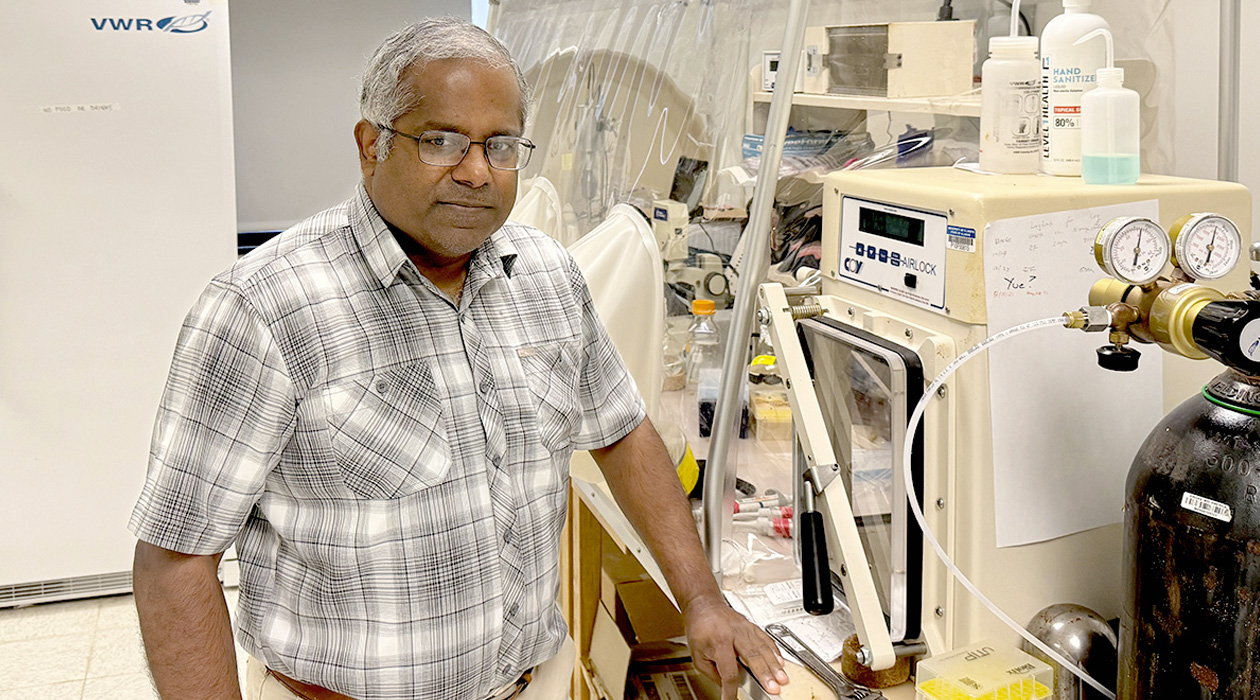Team discovers naturally occurring DNA-protein hybrids

Illinois biochemistry professor Satish Nair and his colleagues discovered a new class of DNA-protein hybrids and determined the mechanisms by which they are formed in bacterial cells. The findings will speed the process of finding and developing new DNA-protein hybrid molecules for therapeutic use. / Christine des Garennes
Thanks to a serendipitous discovery and a lot of painstaking work, scientists can now build biohybrid molecules that combine the homing powers of DNA with the broad functional repertoire of proteins — without having to synthesize them one by one, researchers report in a new study. Using a naturally occurring process, laboratories can harness the existing molecule-building capacities of bacteria to generate vast libraries of potentially therapeutic DNA-protein hybrid molecules.
The findings are detailed in the journal Nature Chemical Biology.
“Two of the most common building blocks in biology are nucleic acids — used for making RNA and DNA — and amino acids, which make up proteins,” said University of Illinois Urbana-Champaign biochemistry professor Satish Nair (MMG), who led the study with postdoctoral researcher Zeng-Fei Pei. “We have these two sets of biological molecules that do very different things, and, for decades, chemists have been trying to integrate them into the same molecule. If you can make a complex protein and then put a nucleic acid on it that makes it go exactly where you want it to go because it will bind to specific regions of DNA or RNA, you can build a precision drug.”
Such drugs can be used to interrupt various disease-promoting processes in the cell, blocking the transcription of mutated genes, for example, or binding to pathogenic noncoding RNA molecules to stall their activity, Nair said.
The initial discovery was serendipitous, he said. He and his colleagues had been looking for proteins that bind to metals when they noticed that a team at the John Innes Centre in Norwich, England, had reported on a bacteria-generated molecule of interest that appeared to be a DNA-protein hybrid.
The Illinois team contacted the Innes Centre scientists, Natalia Vior and Andrew Truman, suggesting they re-examine the molecule to determine if it was in fact what it appeared to be. Once that initial discovery was confirmed, the American and English scientists collaborated on a more in-depth analysis to discover the molecular mechanisms that formed the hybrid.
Finding a naturally occurring DNA-protein hybrid and determining how a bacterium can be induced to make it would streamline what is now a slow, labor-intensive process, Nair said.
“Lots of high-powered laboratories all over the world have been using various synthetic chemical methods to make biohybrid molecules, and that’s great: They’re all proof-of-concept and it works,” he said. “The problem is that you can’t do it at large scale. You can’t make 100 million compounds because that would require you to do the chemical synthesis 100 million times.”
In a series of experiments, Nair and his colleagues found that two bacterial enzymes together convert certain peptides into DNA-protein hybrids. The first enzyme, YcaO, modifies an amino acid in the peptide to convert the peptide into a ring structure like the bases that allow DNA and RNA to pair with other DNA or RNA molecules. The second enzyme is a protease that cuts off one part of the newly modified molecule, converting it into a fully functional nucleobase-protein hybrid.
The team was able to make the conversion in a test tube by adding only three ingredients: the original peptide and the two enzymes. But they also demonstrated that the process could be carried out by the bacterium E. coli.
Understanding this process will allow laboratories to create hybrid molecules that can attach to any region of the genome or any RNA molecules in cells, Nair said. Using bacteria to streamline the pipeline will speed the process of discovery.
“Now, we’re off to the races,” he said.
The National Institutes of Health and the Biotechnology and Biological Research Council supported this research.
